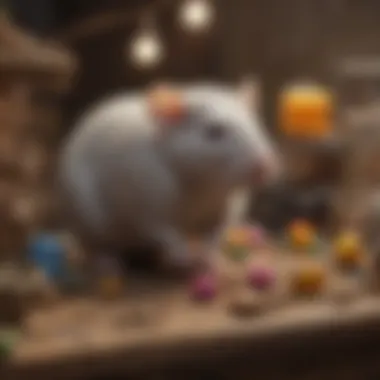Understanding Multi-Level Rat Cages: A Complete Guide


Intro
Understanding the intricate needs of pet rats is crucial for any owner. Multi-level rat cages provide an ideal environment that caters to the habits and natural behaviors of these animals. This guide will detail the significance of these cages, examining their design, benefits, and maintenance to ensure a healthy and stimulating habitat for pet rats.
Understanding Your Pet
A solid understanding of your pet is the first step to providing the best care. Knowing their behavior, breed characteristics, and specific needs will help create a comfortable living space.
Pet Behavior Basics
Rats are social creatures. They thrive in environments that allow exploration and interaction. In a multi-level cage, rats can climb, hide, and build nests. This setup mirrors their natural habitat and stimulates their instincts. It is essential to provide various levels and spaces for them to engage with.
Common Breed Characteristics
Different rat breeds may exhibit unique traits. For instance, Dumbo rats are known for their large ears and friendly nature, while Hairless rats may require special consideration due to their lack of fur. Understanding the specific needs of your breed can enhance their living conditions.
Species-Specific Needs
Rats need both mental and physical stimulation. A multi-level cage should include diverse features: tunnels, ramps, and hammocks. These elements encourage activity and prevent boredom. Such enrichment is vital for their well-being.
Pet Care and Maintenance
Taking care of your pet rat involves more than just providing food. Regular maintenance of their living environment is essential for a happy and healthy life.
Feeding Guidelines
A balanced diet is crucial. Rats should have access to a variety of foods, including high-quality rat pellets and fresh fruits and vegetables. Always consult a vet for specific dietary advice based on your rat's needs.
Grooming Essentials
Rats are relatively low-maintenance when it comes to grooming. However, it is important to check their fur and skin for signs of issues. Regular baths should be avoided unless absolutely necessary.
Hygiene Practices
Keeping the cage clean is paramount. Remove waste daily and conduct a more thorough cleaning weekly. This practice prevents odors and keeps your pet healthy.
Training and Development
Training your pet rat can be beneficial for both you and the animal. It builds a bond and enhances their living experience.
Basic Commands and Skills
Teaching simple commands can improve behavior. Start with basic actions, like coming when called. Consistency is key in training.
Behavioral Training Techniques
Positive reinforcement works well with rats. Use treats to encourage good behavior. Avoid punishment, as it can lead to fear and anxiety.
Addressing Common Behavior Issues
If your rat displays unwanted behavior, first understand the cause. It may stem from stress, boredom, or health issues. Adjust their environment or consult a vet if necessary.
Health and Wellness
Routine health check-ups are important to maintain your pet's well-being.
Routine Vet Check-ups
Regular visits to the veterinarian help identify potential health issues early. This is critical for the prevention of serious conditions.
Vaccination Needs
Discuss vaccination options with your vet. Some conditions can be prevented through vaccination. Being proactive is better than remedial treatment.
Recognizing Signs of Illness


Be aware of common signs that your rat may be unwell. These include changes in behavior, appetite, or grooming habits. Quick action can prevent further complications.
Enrichment and Activities
An enriched environment enhances a rat's quality of life. Providing activities that aid in their development is beneficial.
Indoor vs.
Outdoor Activities
While indoor play is common, safe outdoor time can be beneficial. Just ensure it’s a secure area.
Interactive Toys and Games
Investing in interactive toys, such as tunnels and chews, can keep r.ts engaged. Rotate toys to keep things fresh.
Socialization Opportunities
Rats are social animals. Make sure they have chances to interact with other rats and with you. This social play is vital for their emotional health.
Providing a multi-level rat cage helps create a stimulating environment that caters to your pet’s natural behaviors and needs. It is an investment in their overall quality of life.
Prolusion to Multi-Level Rat Cages
Multi-level rat cages are not just a trend; they are a necessity for optimal rat care. Understanding their importance is vital for rat owners. A multi-level design provides a more dynamic and engaging environment compared to traditional single-level cages. This design enables rats to explore, interact, and engage in activities that enrich their lives.
Defining Multi-Level Rat Cages
Multi-level rat cages are enclosures designed with multiple tiers or levels. Each level typically connects via ramps or ladders, allowing rats to move easily between them. The structure usually includes various layouts, such as corner shelves and horizontal spaces, maximized for activity and comfort. This design is essential for promoting physical health and preventing boredom, as rats are naturally curious and need stimulation.
Importance of Proper Housing
Appropriate housing is critical for the well-being of pet rats. Multi-level cages fulfill several functions. First, they provide enough space for climbing, which is vital for their physical fitness. Additionally, these cages can help prevent behavioral issues arising from confinement. They foster natural behaviors like nesting and exploring, ultimately contributing to happier and healthier pets.
Proper housing not only enhances the quality of life but also promotes better health in pet rats.
Choosing an inadequate cage can lead to stress and health problems. Thus, understanding multi-level rat cages equips owners to make informed choices that benefit their pets. As more people recognize the significance of proper housing, the trend towards multi-level designs is expected to grow. Ultimately, investing in a suitable cage is an investment in the overall health and happiness of pet rats.
Benefits of Multi-Level Designs
Multi-level rat cages offer distinct advantages that enhance the living conditions for pet rats. The importance of these benefits cannot be understated, especially when it comes to their health and overall happiness. This section will detail how a well-designed multi-level structure contributes to various aspects of a rat's life.
Enhanced Space Utilization
One of the primary benefits of multi-level rat cages is the efficient use of space. In a single-level cage, the area for exploration and activity is limited. However, a multi-level design allows pet rats to utilize vertical space effectively. This is particularly relevant for small living environments, where square footage may be at a premium.
Having multiple platforms and shelves means that rats can climb, jump, and explore their habitat more thoroughly. It not only keeps them physically engaged but also enhances their ability to express natural behaviors like climbing and burrowing. With this design, owners can create a more dynamic environment, allowing for better interaction among the rats themselves.
Improved Interaction and Exploration
Multi-level cages foster an environment where interaction is more likely. Rats are social creatures, and an environment where they can navigate different heights creates opportunities for them to bond with each other. When rats have the ability to roam freely across various levels, they tend to engage in playful activities, which is crucial for their emotional well-being.
Exploration is also greatly enhanced. Rats are naturally curious animals. With multiple levels to explore, they are more inclined to investigate their environment, which stimulates both their mental and physical health. They can find hidden spaces or toys placed at different heights, making their habitat more enticing and stimulating.
Encouraging Natural Behaviors
Lastly, a well-structured multi-level cage promotes natural behaviors among pet rats. In the wild, rats spend time climbing, digging, and nesting. A multi-level cage offers the opportunity to replicate this environment, leading to happier, healthier pets. It allows for the incorporation of various substrates and materials that encourage digging or burrowing.
Key Features to Consider
Understanding the essence of multi-level rat cages demands attention to specific features that ensure the well-being and contentment of your pet rats. Selecting the right cage is not merely about aesthetics; it involves a thorough examination of materials, levels, and accessibility. Each of these elements plays a pivotal role in creating a safe and engaging environment for your furry companions.
Material and Construction
The choice of material is crucial when purchasing a multi-level rat cage. Durable construction safeguards against wear and tear, ensuring longevity. Wire cages are popular because they provide ventilation and visibility. However, the spacing between the bars should be narrow enough to prevent escapes or injuries. Metal frames enhance the strength of the cage, while plastic components facilitate easier cleaning.
Moreover, consider non-toxic materials. Rats are curious and will chew on their surroundings. Thus, ensuring materials do not off-gas harmful substances is vital. In addition, cages should be designed to resist rust and corrosion. This maintans aesthetics and promotes hygiene.


Lastly, attention to construction quality matters. A sturdy cage will contribute to the overall safety, allowing your pets to explore without risk of accidental collapses or injuries. A well-constructed cage reflects a commitment to pet care.
Levels and Platforms
The design of levels and platforms is another core feature in multi-level rat cages. Multiple levels encourage natural climbing behaviors, hence promoting exercise and engagement. Platforms can be placed at varying heights, facilitating exploration at different heights. Be mindful of the width and sturdiness of these platforms. Sufficient space must be permitted for rats to rest comfortably.
Using platforms also boosts space efficiency. Rather than a broad horizontal layout, vertical space can maximize the living area. This is particularly beneficial for smaller living arrangements.
Moreover, adding different textures can create sensory stimulation. For instance, some platforms can have carpet or wood, which is enjoyable for rats as they explore. Additionally, removable platforms ease cleaning, contributing to ongoing hygiene routines.
Accessibility and Navigation
Accessibility is paramount in multi-level rat cages. All areas must be reachable for your rats. This is where ramps or ladders come in. These features provide easy navigation between levels. Ensure slopes are gentle to prevent slips or falls, which could cause injury. Placement of ramps should be strategic, connecting higher levels with lower ones seamlessly.
It is important to layout the cage so every section invites exploration. Observe your rats as they navigate their space. They may prefer certain routes and spaces over others. Interactive elements, such as tubes or hiding spots, can improve accessibility by stimulating natural curiosity and encouraging exploration in safe ways.
"The right cage is essential to your pet's quality of life. Consider their needs above all."
Choosing the Right Cage
Choosing the right cage for your pet rats is a critical decision. It affects not only the comfort of your pets but also their overall well-being. A suitable cage provides enough space for them to roam and play, while ensuring safety and accessibility. Each rat has its preferences and needs, making it essential to consider various factors before making a purchase.
Factors Influencing Your Selection
Many elements can influence what cage is best for your rats. These include:
- Size and Space: Rats are social creatures and require ample space. A multi-level cage provides more areas for exploration. Aim for a cage that offers at least two square feet of floor space per rat, and ensure it has multiple levels.
- Material: The cage material can determine durability and safety. Metal cages are usually the best as they are difficult for rats to chew through. Avoid plastic models, as they may not withstand the enthusiastic activity of active rats.
- Bar Spacing: The spacing between the bars can also affect safety. Bars should be close enough to prevent your rats from escaping or getting their heads stuck. Generally, a spacing of half an inch is advisable for small to medium rats.
- Ease of Cleaning: Maintenance is crucial for pet health. Look for a cage with removable trays for easy cleaning. A design that allows for quick access to all areas of the cage is also beneficial.
- Budget: While it's important to invest in a quality cage, it's also essential to stick to your budget. There are various models available across a wide price range. Ensure that the chosen cage meets both your financial limitations and the welfare needs of your rats.
Popular Brands and Models
When it comes to choosing a cage, certain brands have earned a reputation for quality and reliability. Some of the most recognized include:
- Critter Nation: Known for its spacious design and customizable levels. Its sturdy build and ease of access make it a popular choice among rat owners.
- Ferplast Cavie: This brand offers multi-level options with ample space. The design focuses on safety and ease of cleaning, features that rat owners appreciate.
- MidWest Homes for Pets: Their ferret nation line is also suitable for rats. It is well-constructed and provides excellent vertical space.
- PawHut: This brand offers budget-friendly options without compromising much on quality. Generally, it offers cages that are well-suited for multi-level living.
Choosing the right cage is fundamental. It needs to address rats' natural curiosity and energetic behavior. Investing in a well-thought-out cage can lead to healthier, happier pets.
Ultimately, selecting the right cage is about balancing your pets' needs with your preferences and constraints. Take the time to research, and consider visiting pet supply stores to see cages firsthand. This approach lets you better understand what may suit your home and lifestyle.
Setting Up the Cage
Setting up the cage for your pet rats is not only about providing a physical space for them to live in. It's about creating an environment that supports their health, happiness, and social behaviors. Multi-level rat cages offer a unique opportunity to mimic the natural habitats of rats, allowing for vertical space that promotes exploration and activity. This section will cover essential accessories, how to arrange the levels and platforms, and ways to create a stimulating environment for your pets.
Essential Accessories
When setting up a multi-level cage, equipping it with the right accessories is crucial. These accessories contribute to the well-being of your rats by encouraging activity and offering comfort. Here are some essential items to consider:
- Food and water bowls: Ensure these are accessible on multiple levels to encourage movement.
- Hideouts and tunnels: Providing places where rats can hide instills a sense of security.
- Bedding material: Soft bedding material is important for comfort and health. Consider options like aspen shavings or paper-based bedding.
- Climbing equipment: Ropes or hammocks can enhance climbing and exploring, catering to their natural instincts.
- Exercise wheels: A solid surface wheel is ideal. Rats are active and need outlets for their energy, which helps prevent obesity and boredom.
It is essential to regularly check and maintain these accessories to ensure they are clean and safe for your pets.
Arranging Levels and Platforms
The arrangement of levels and platforms within the cage is vital for encouraging rat activity. Each level should be spaced appropriately so that all rats can access them without difficulty. Here are some points to consider while arranging:
- Vertical Layout: Use the height of the cage creatively. Levels should be arranged so that rats can easily jump or climb between them. This design mimics their natural climbing behavior.
- Safety First: Ensure that all levels are stable and secure. Avoid materials that can tip or collapse under the rats' weight.
- Accessibility: Include ramps or ladders to facilitate movement between the different areas. The ramps should not be steep; a gentle incline is best.
- Multi-Zone Areas: Designate specific areas for eating, playing, and sleeping. This helps rat establish routines and promotes overall happiness.
Creating a Stimulating Environment
A stimulating environment keeps your rats mentally and physically engaged. Boredom can lead to destructive behaviors or health issues. Here are strategies to foster stimulation in your setup:
- Rotate Accessories: Periodically changing toys or hideouts can prevent monotony and introduce new challenges.
- Interactive Toys: Offer toys that promote problem-solving such as treat-dispensing toys to encourage active play.
- Social Spaces: Rats are social animals. Ensure they have enough room for social interactions. Seating areas can be placed where they can comfortably gather without overcrowding.
- Scent Enrichment: Occasionally adding new scents, such as fresh herbs, to bedding can stimulate their sense of smell and curiosity.
By providing the right setup and stimulating elements, you can enhance the quality of life for your pet rats. A well-designed multi-level cage can serve as a mini habitat that meets their behavioral needs effectively.
Nutrition and Care Considerations
Understanding nutrition and care is fundamental for the health and happiness of your pet rats. A multi-level rat cage, while providing space for exploration, can only be beneficial if the basic needs of the animals are met. This section discusses key aspects including food and water accessibility, hygiene maintenance, and handling techniques that nurture the bond between you and your pets.


Food and Water Accessibility
Providing adequate food and water is crucial for the well-being of your rats. Their diet should consist mainly of high-quality rat pellets, which are formulated to provide complete nutrition. In addition to pellets, you can offer fresh fruits and vegetables as supplements. However, careful selection is needed as some foods can be harmful.
Water is equally important. Ensure that fresh and clean water is always available. Using a water bottle with a no-drip spout can help keep things clean and prevent spills within the cage. Remember to check the bottle daily to confirm it is working properly and that water is flowing. This ensures that your pets stay hydrated, avoiding potential health issues.
Maintaining Hygiene and Cleanliness
A clean environment is vital for the health of your rats. Regular cleaning of the cage prevents the buildup of waste and bacteria, reducing the risk of disease. Spot cleaning should be done daily, where you remove any soiled bedding and leftover food. Furthermore, a more thorough clean should happen weekly or bi-weekly. This involves removing all bedding, washing the cage with a pet-safe cleaner, and rinsing thoroughly to eliminate any residue.
Consider using paper-based bedding, which is absorbent and reduces odors. Avoid cedar or pine shavings as these can cause respiratory issues. Maintaining hygiene not only benefits your animals’ health but also enhances the overall environment within the living space.
Handling and Bonding with Your Pets
Establishing a bond with your rats is both rewarding and necessary for their well-being. Regular handling helps your pets become accustomed to human interaction, which can reduce stress during handling and transportation. Initially, allow your rats to approach you, offering treats to encourage trust. Gradually, pick them up using both hands for support, especially for younger or timid rats.
Spending time with your rats outside their cage can also strengthen your relationship. Creating a safe area for them to explore enhances their confidence and helps them to engage in natural behaviors. Remember, patience is key. Each rat has its personality, and some may take longer to warm up than others.
Establishing a connection fosters a harmonious environment, promoting better health and behavioral outcomes.
By paying attention to nutrition and care considerations, owners can significantly improve the quality of life for their pet rats. This preparation not only ensures the physical health of these small creatures but also enhances emotional well-being through strong human-animal bonds.
Common Mistakes to Avoid
Understanding the common mistakes that owners make when selecting and managing a multi-level rat cage is crucial for ensuring the health and welfare of pet rats. These errors can compromise the living conditions for rats and ultimately impact their well-being. In this section, we will discuss three major mistakes pet owners often make: overcrowding the cage, ignoring safety features, and neglecting social interaction.
Overcrowding the Cage
Overcrowding a rat cage is one of the most common mistakes pet owners can make. When multiple rats share a small space, it can lead to stress and aggressive behaviors. Each rat requires its own territory to thrive. It is important to consider the size of the cage in relation to the number of rats you plan to house. The general guideline is to provide at least 2 cubic feet of space per rat.
Factors to keep in mind include:
- Number of levels and platforms available
- Space for individual sleeping areas
- Accessibility to food and water without competition
When the cage becomes too cramped, rats may exhibit signs of anxiety, which can lead to health problems. Additionally, overcrowding can cause increased waste production, making it harder to maintain hygiene.
Ignoring Safety Features
Safety should always take priority when choosing a multi-level rat cage. Ignoring essential safety features can put rats at risk for injury or escape. Important safety features to consider include:
- Bar spacing: Ensure that the bars are close enough to prevent rats from squeezing through.
- Sturdy construction: The cage should be stable and robust to withstand climbing and jumping rats.
- Non-toxic materials: Selecting cages made of safe, non-toxic materials is vital for preventing health hazards.
Owners should regularly inspect the cage to identify wear and tear that might compromise safety. This vigilance helps to avoid accidents that could lead to injuries.
Neglecting Social Interaction
Rats are highly social animals. Neglecting their social needs can lead to loneliness and related behavioral issues. It is essential to understand that rats thrive in pairs or small groups. Even when housed in a multi-level cage, they require daily interaction with their owners as well as with their cage mates.
To provide adequate social interaction:
- Spend ample time handling and playing with your rats daily.
- Monitor their interactions with one another for signs of dominance or stress.
- If possible, introduce new cage mates gradually, ensuring compatibility.
Social interaction promotes a healthier, happier lifestyle for your rats. Fostering strong bonds contributes to their emotional and psychological well-being.
Keeping these common mistakes in mind will help you create a more suitable and enriching environment for your rats. A well-planned cage leads to happy, healthy pets.
Culmination
Multi-level rat cages serve a multifaceted purpose beyond just housing pet rats. They enhance not only the livability of these environments but also positively impact the physical and mental well-being of the animals. Understanding this concludes that proper design and thoughtful implementation are essential for creating a healthy habitat.
Summary of Key Points
The discussion throughout this article highlights several significant components regarding multi-level rat cages, such as:
- Benefits of Multi-Level Designs: The increased space, enhanced exploration opportunities, and encouragement of natural behaviors are crucial for rats.
- Key Features to Consider: Material quality, accessibility of levels, and overall construction are essential when selecting or designing a cage.
- Common Mistakes to Avoid: Awareness of overcrowding, safety features, and neglecting social needs is vital in ensuring the welfare of pet rats.
- Nutrition and Care: Appropriate nutrition, hygiene, and handling significantly influence a rat's quality of life.
Final Thoughts on Multi-Level Rat Cages
Adopting a multi-level cage setup is more than an aesthetic choice; it is a commitment to fostering a better environment for pet rats. Such configurations mimic their natural habitat, enabling behaviors like climbing and exploring, which contributes to their happiness and health.
In summary, understanding the specifics of multi-level rat cages equips pet owners with the necessary knowledge to nurture their pets effectively. By prioritizing the right features and avoiding common pitfalls, individuals can create a stimulating living space for their rats. Knowledge in this area reinforces the bond between humans and these intelligent creatures, ultimately ensuring a thriving interaction that enriches both parties.
Educating oneself on the needs and preferences of pet rats is the first step in responsible pet ownership.







